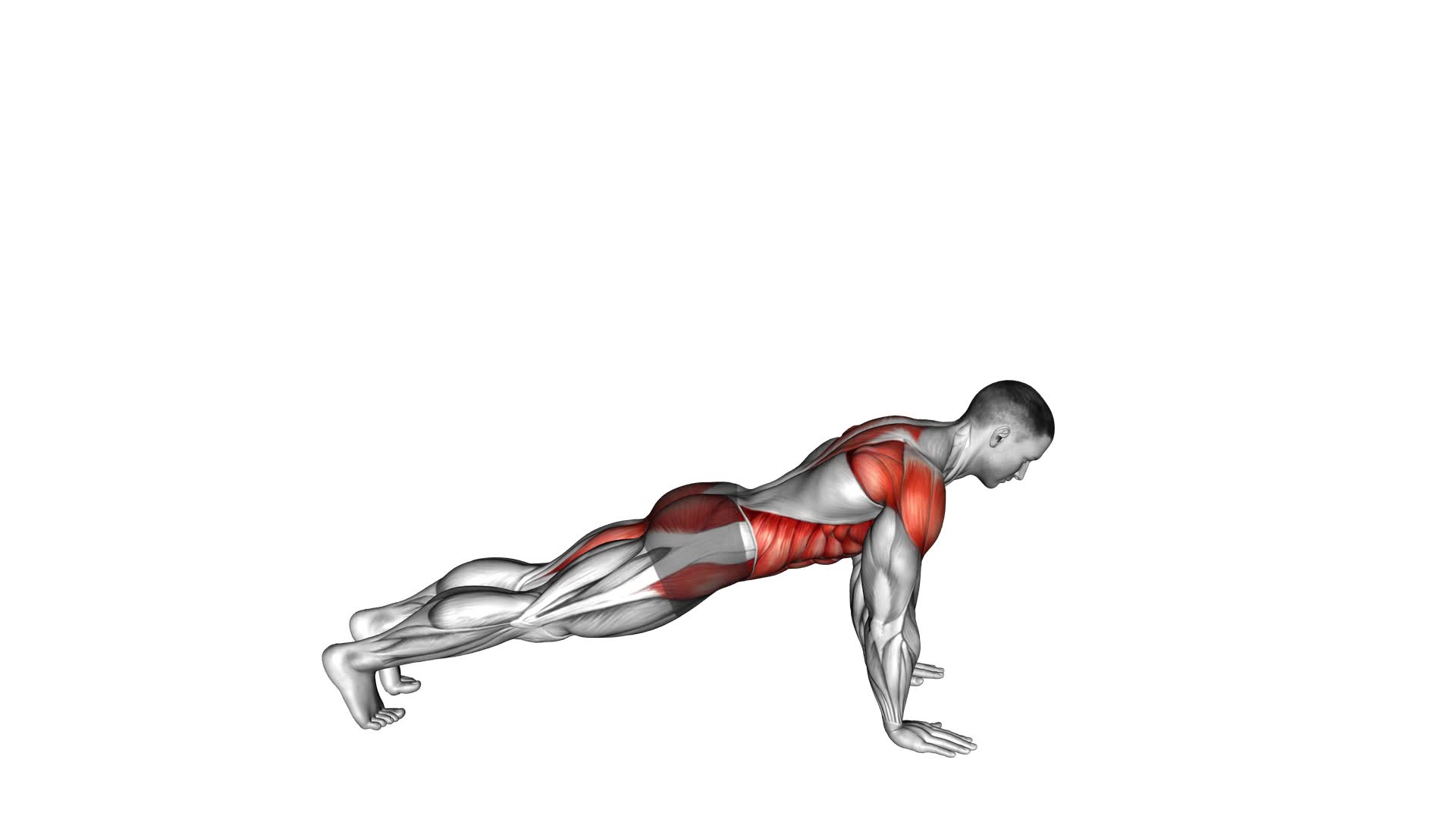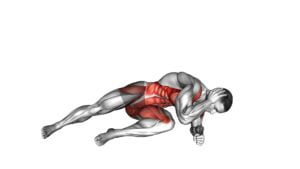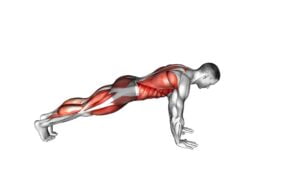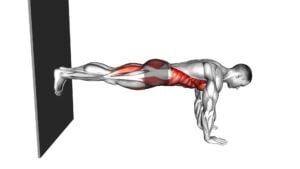Front Plank to Side Plank (male) – Video Exercise Guide & Tips

Looking to strengthen your core and build stability? Check out this video exercise guide for the front plank to side plank.
Watch This Exercise Video
You'll learn the proper form and technique, as well as variations and progressions to challenge yourself.
Avoid common mistakes and get tips for beginners.
Incorporate this exercise into your workout routine for maximum results.
Get ready to feel the burn and take your fitness to the next level.
Let's get started!
Key Takeaways
- Front plank to side plank improves core strength and stability.
- Proper form and technique are essential to maximize the benefits and prevent injury.
- Maintaining core stability is crucial for effective exercise execution.
- Proper shoulder alignment helps prevent injuries and enhances the effectiveness of the exercise.
Benefits of Front Plank to Side Plank
The benefits of the Front Plank to Side Plank exercise include improving core strength and stability. This exercise targets the muscles in your abdominals, back, and hips, helping to increase your overall core strength. By holding the plank position, you're engaging your deep core muscles, such as the transverse abdominis and obliques, which are crucial for stability and support. This increased core strength can translate into better posture, reduced risk of injury, and improved overall athletic performance.
Additionally, the Front Plank to Side Plank exercise also helps to improve balance and stability. As you transition from the front plank to the side plank position, your body has to work harder to maintain its balance. This not only challenges your core muscles, but also engages your shoulder, hip, and leg muscles, further enhancing your overall stability. By practicing this exercise regularly, you can improve your body's ability to maintain balance in various positions and movements.
Now that you understand the benefits of the Front Plank to Side Plank exercise, let's move on to discussing the proper form and technique to ensure you get the most out of this exercise.
Proper Form and Technique
To perform the Front Plank to Side Plank exercise with proper form and technique, there are a few key points to keep in mind.
First, focus on maintaining core stability throughout the movement by engaging your abdominal muscles and keeping your body in a straight line.
Second, pay attention to proper shoulder alignment by keeping your shoulders stacked directly above your wrists or elbows, depending on the variation you choose.
Maintaining Core Stability
Maintain core stability by engaging your core muscles and using proper form and technique. Here are three key tips to help you maintain core stability during your exercises for core strength:
- Keep your core muscles activated: Focus on drawing your belly button towards your spine and engaging your deep abdominal muscles. This will help stabilize your spine and maintain proper alignment.
- Control your breathing: Breathing properly is essential for maintaining core stability. Exhale as you contract your core muscles and inhale as you relax. This will help you maintain control and stability throughout your exercises.
- Maintain proper alignment: Whether you're performing a plank or a side plank, it's important to maintain a straight line from your head to your heels. Avoid sagging or arching your back, as this can put unnecessary stress on your spine and compromise your core stability.
Proper Shoulder Alignment
Engage your shoulder muscles to ensure proper alignment and form during the Front Plank to Side Plank exercise. Proper shoulder alignment is crucial for preventing injuries and maximizing the effectiveness of this exercise.
To improve shoulder alignment, you can incorporate specific shoulder alignment exercises into your workout routine. These exercises focus on strengthening the muscles responsible for stabilizing the shoulders, such as the rotator cuff muscles.
Additionally, paying attention to your posture throughout the day can help prevent common shoulder alignment issues. Avoid slouching or rounding your shoulders forward, as this can cause imbalances and poor alignment.
Variations and Progressions
Now let's explore the different plank positions and how they can increase the difficulty level of your workout.
By incorporating variations such as side planks, forearm planks, or elevated planks, you can target different muscle groups and challenge your core in new ways.
Progressions are essential in any exercise routine as they help improve strength and stability over time.
Different Plank Positions
To challenge yourself and target different muscle groups, try incorporating various plank positions into your workout routine. Here are three different plank variations that you can try:
- Side Plank: Start by lying on your side with your forearm on the ground and your body in a straight line. Lift your hips off the ground, creating a sideways plank position. This exercise targets the obliques and improves core stability.
- Spiderman Plank: Begin in a traditional plank position. As you hold the plank, bring one knee towards your elbow on the same side, engaging your obliques and hip flexors. Alternate sides for a challenging core and upper body workout.
- Plank with Shoulder Taps: Get into a high plank position and lift one hand off the ground to tap the opposite shoulder. Repeat on the other side. This variation increases core stability and challenges your balance.
Increasing Difficulty Levels
To progress your plank exercises and increase the difficulty levels, try incorporating variations and progressions into your routine.
There are different progression levels you can explore to challenge your muscles and take your plank exercises to the next level.
One option is to increase the duration of your plank holds. Start by holding the front plank for 30 seconds and gradually work your way up to a minute or more.
Another modification option is to add movement to your plank exercises. For example, you can try lifting one leg or arm off the ground while maintaining a stable core. This engages more muscles and increases the difficulty of the exercise.
Remember to always maintain proper form and alignment throughout your plank variations and progressions.
Benefits of Progressions
As you progress your plank exercises and incorporate variations and progressions into your routine, you'll experience the benefits of challenging your muscles and taking your workouts to the next level.
Here are three reasons why progression techniques and muscle engagement are important:
- Increased muscle activation: By adding variations and progressions to your planks, you engage different muscle groups, including your core, shoulders, and glutes. This helps to strengthen and tone these muscles more effectively.
- Improved stability and balance: Progressions such as the front plank to side plank challenge your stability and balance. As you master these exercises, your body becomes more stable, reducing the risk of injury during other activities.
- Enhanced overall strength: By constantly challenging your muscles through progression techniques, you'll see improvements in your overall strength. This won't only benefit you during your plank exercises but also in other activities and sports.
Incorporating variations and progressions into your plank routine won't only make your workouts more exciting but also maximize your results by targeting different muscle groups and improving your overall strength and stability.
Common Mistakes to Avoid
Are you making any common mistakes during the Front Plank to Side Plank exercise? Proper alignment is crucial for maximizing the benefits of this exercise and avoiding potential injuries.
One common mistake is sagging or arching your back. When performing the front plank, your body should form a straight line from your head to your heels. Avoid letting your hips sink or your lower back curve.
Another mistake isn't engaging your core muscles enough. The plank exercise is designed to target your core, so it's important to actively engage your abdominal muscles by pulling your belly button towards your spine.
Lastly, avoid placing too much weight on your supporting arm during the side plank. Instead, distribute your weight evenly between your forearm and your feet, ensuring that your body remains in a straight line.
Tips for Beginners
If you're a beginner, start by focusing on proper form and engaging your core muscles during the Front Plank to Side Plank exercise. This will help you build a strong foundation and prevent injuries. Here are some tips to help you get started:
- Beginner modifications: If you find the Front Plank to Side Plank exercise too challenging, don't worry. You can modify it by starting on your knees instead of your toes. This reduces the amount of weight on your upper body and allows you to focus on engaging your core muscles. As you get stronger, you can gradually progress to the full exercise.
- Engage your core: One common misconception is that the Front Plank to Side Plank exercise only targets your arms and shoulders. In reality, it's a full-body exercise that primarily works your core. Make sure to keep your abdominal muscles tight throughout the movement to maximize the benefits.
- Take it slow: Another common mistake beginners make is rushing through the exercise. Remember to start with a slow and controlled movement. This will help you maintain proper form and ensure that you're engaging the right muscles.
Incorporating Front Plank to Side Plank Into Your Workout Routine
To incorporate the Front Plank to Side Plank exercise into your workout routine, begin by selecting a suitable time and place. The Front Plank to Side Plank is a challenging exercise that targets your core muscles and helps improve your overall core strength. Incorporating plank exercises into your routine can have numerous benefits, such as building a strong and stable core, improving posture, and reducing the risk of lower back pain.
When adding the Front Plank to Side Plank to your workout, it's important to start with proper form and technique. Begin by getting into a front plank position, with your forearms on the ground and your body in a straight line from head to toe. Engage your core muscles and hold this position for a few seconds.
Then, transition into a side plank by rotating your body to the side, resting on one forearm and stacking your feet on top of each other. Hold this position for a few seconds before returning to the front plank. Repeat this exercise for a set number of repetitions or time.
To maximize the benefits of incorporating the Front Plank to Side Plank into your workout routine, aim to perform this exercise two to three times a week. Start with a few repetitions and gradually increase the difficulty as your core strength improves. Remember to listen to your body and take breaks when needed.
With consistency and proper form, you'll gradually build core strength and achieve your fitness goals.
Frequently Asked Questions
How Many Calories Can Be Burned by Doing Front Plank to Side Plank?
When it comes to burning calories, exercises like the front plank to side plank can be effective. However, it's important to note that the exact number of calories burned can vary based on factors like your weight, intensity, and duration of the exercise.
Additionally, it's crucial to warm up properly before engaging in any exercise routine to prevent injuries and optimize performance. Incorporating a warm-up routine into your workout can help increase calorie burn and improve overall fitness.
Is It Necessary to Warm up Before Performing Front Plank to Side Plank?
Before performing any exercise, it's always important to warm up to prevent injuries and get your muscles ready for action.
Incorporating planks into your workout routine has numerous benefits, such as strengthening your core, improving posture, and increasing overall body stability.
There are different variations of plank exercises, including the front plank and side plank, that target different muscles and add variety to your routine.
Can Front Plank to Side Plank Help in Improving Posture?
Front plank to side plank is an effective exercise for improving posture. By engaging your core muscles, this exercise helps to strengthen the muscles that support proper alignment of the spine.
Additionally, the front plank to side plank exercise can also help in toning your abs. By incorporating this exercise into your routine, you can work on both your posture and abdominal strength simultaneously.
Are There Any Modifications for Individuals With Lower Back Pain?
If you're dealing with lower back pain, there are modifications you can make to the Front Plank to Side Plank exercise. It's important to listen to your body and not push yourself too hard.
Instead of going all the way down to the floor, you can start with your knees bent and your hips slightly lifted. This will help alleviate pressure on your lower back while still working your core.
As you build strength, you can gradually increase the difficulty of the exercise.
How Often Should Front Plank to Side Plank Be Performed for Optimal Results?
To get optimal results from front plank to side plank, it's important to perform the exercise regularly. By incorporating front plank to side plank variations into your workout routine, you can target multiple muscle groups and improve core strength and stability.
The benefits of this exercise include improved posture, enhanced balance, and increased overall body strength. Aim to do front plank to side plank exercises at least 2-3 times a week for best results.
Remember to listen to your body and make modifications as needed to avoid any discomfort or injury.
Conclusion
Incorporating the front plank to side plank exercise into your workout routine can provide numerous benefits, including improved core strength, stability, and balance.
By maintaining proper form and technique, avoiding common mistakes, and gradually progressing through variations, you can maximize the effectiveness of this exercise.
Remember to start with the basics and gradually increase the difficulty level as you become more comfortable and stronger.
Stay consistent and dedicated to see the best results from this exercise.

Author
Years ago, the spark of my life’s passion ignited in my mind the moment I stepped into the local gym for the first time. The inaugural bead of perspiration, the initial endeavor, the very first surge of endorphins, and a sense of pride that washed over me post-workout marked the beginning of my deep-seated interest in strength sports, fitness, and sports nutrition. This very curiosity blossomed rapidly into a profound fascination, propelling me to earn a Master’s degree in Physical Education from the Academy of Physical Education in Krakow, followed by a Sports Manager diploma from the Jagiellonian University. My journey of growth led me to gain more specialized qualifications, such as being a certified personal trainer with a focus on sports dietetics, a lifeguard, and an instructor for wellness and corrective gymnastics. Theoretical knowledge paired seamlessly with practical experience, reinforcing my belief that the transformation of individuals under my guidance was also a reflection of my personal growth. This belief holds true even today. Each day, I strive to push the boundaries and explore new realms. These realms gently elevate me to greater heights. The unique combination of passion for my field and the continuous quest for growth fuels my drive to break new ground.







